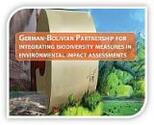3th EIA Workshop in Bonn-Germany, 25-29 September 2017
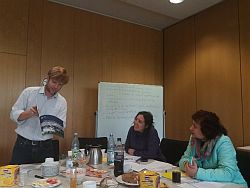
The 6th workshop of the project, took place for the third time in Bonn, with the participation of: Estela Herbas Baeny (UCB), Gonzalo Navarro Sánchez (UCB), Wanderley Ferreira (External expert Bolivia), Ericka Lafuente Mijaria (UCB), Lisa Freudenberger (ZEF), Jan Henning Sommer (ZEF), Candan Ergeneman (ZEF), Vanessa Gandarillas (UCB/ZEF) and Lorena Guzmán Wolfhard (ZEF).
The main objectives of this workshop were to discuss the current state of the project, to present and analyze achieved results so far and to analyze possible future opportunities to continue the collaboration after 2018.
An important aspect of the workshop was to discuss the implementation of new concepts involved in the recent State Integrated Planning System (SPIE) and Territorial Plan for Integral Development (PTDI) 2016-2020. The most critical aspects of both frameworks were reviewed and noted in the workshop minutes. Furthermore a relevant point within this reconceptualization was the one towards the “systems of life”, new concept included in the Bolivian legal system Law 777 (SPIE), Law 071 Law of the Mother Earth, Law 300 “Well living” and others.
During the first two days, participants of the workshop presented and discussed the so far obtained results, including the presentation of the book “Towards the integration of biodiversity in Environmental Impact Assessments of Bolivia” published in June 2017 and the presentations from both PhD Students´ Doctoral Thesis Proposal.
Additional significant aspects were reached during the workshop: 1) the initiation of the elaboration of a first Policy Brief with the aim to disseminate at Bolivian government level the project´s approaches, the challenges and opportunities identified in the current EIA system and pointing to possible future alternatives; and 2) the continuation of the proposition of a legal-political analysis.
Moreover, several aspects to which the Project can contribute in the context of re-conceptualization were highlighted and are shown in the following points:
- Facilitate and guide the understanding and management of proposed environmental units of interpreted dynamically analysis (series and geo-series of vegetation in living areas).
- Guidelines for the standardization of live zones in the form of a unique spatial basis at the national level.
- Proposals to quickly assess the initial state of conservation of the life zones where projects are to be implemented.
- Determine macro-trends of land use change (territory) to model future scenarios of environmental degradation in Bolivia.
- Propose criteria to identify, delimit and internally zonify the area of influence of a project.
- Identify, propose and characterize a national set of critical strategic environmental factors, according to Life zones.
- Technical proposals for an integrated dynamic assessment of environmental impacts under the current state planning system.
- To propose technical guidelines for a National System of Environmental Restoration differentiated accordingly to life zones.
- Write a methodological guide for the use of environmental units of analysis in strategic environmental assessment and EIAs.
- Draft of an EIA procedure guide within the framework of a strategic environmental assessment.
Furthermore, some schemes and conceptual maps were developed with the objective to explain concepts and future plans.
On the third and fourth day, the next steps to achieve missing goals, including future to do tasks, were set up. Responsibilities were distributed among the participants, including death lines and specific assignation of tasks. Finally, some possibilities of continuation of collaboration after 2018 was discussed including new proposal opportunities.
Some excursions were besides prepared to give practical examples of biodiversity in Germany and the different methods for their study and conservation.
Determine macro-trends of land use change (territory) to model future scenarios of environmental degradation in Bolivia.
Propose criteria to identify, delimit and internally zonify the area of influence of a project.
Identify, propose and characterize a national set of critical strategic environmental factors, according to Life zones.
Technical proposals for an integrated dynamic assessment of environmental impacts under the current state planning system.
To propose technical guidelines for a National System of Environmental Restoration differentiated accordingly to life zones.
Write a methodological guide for the use of environmental units of analysis in strategic environmental assessment and EIAs.
Draft of an EIA procedure guide within the framework of a strategic environmental assessment.
Furthermore, some schemes and conceptual maps were developed with the objective to explain concepts and future plans.
On the third and fourth day, the next steps to achieve missing goals, including future to do tasks, were set up. Responsibilities were distributed among the participants, including death lines and specific assignation of tasks. Finally, some possibilities of continuation of collaboration after 2018 was discussed including new proposal opportunities.
Some excursions were besides prepared to give practical examples of biodiversity in Germany and the different methods for their study and conservation.
Excursions
Wednesday 27.09 Guided visit through the installations of the Museum König in Bonn
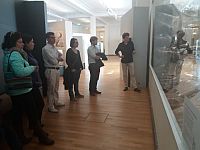
The objective of the visit was for the participants to get acquainted with the museum´s research activity, its documentation and the knowledge transfer for general public.
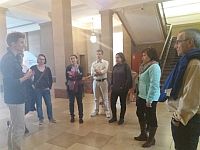
In the museum they were able to appreciate various species of different parts of the world among the more than 5 million units stored at this place since 1912
Thursday 28.09 Guided visit in the Botanic gardens in Bonn
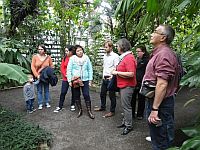
The aim of this guided visit was to give a practical insight of the plant collection in Germany.
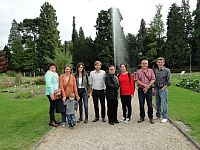
The participants trekked through part of the Botanic gardens and recognized trees and plants from different parts of the world, including the amazing Amorphophallus titanum, many species of carnivorous plants and conifers among others.
Friday 29.09 Guided tour to NABU-Bonn, including lecture on environmental planning and evaluation in Germany.
Excursion in Kiesgrube Dünstekoven
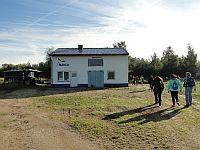
As an introductory presentation, members of the NABU Bonn gave an explanation about the history and projects NABU is developing for the protection of fauna (many species of birds, amphibians and insects specially) and flora in the area.
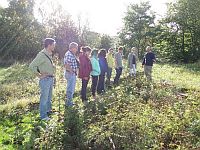
During the excursion participants were able to observe the environmental education projects NABU is developing for different groups. For example, one area is especially dedicated to show the different succession states of local plant species. Moreover, special habitats were “re-created” for allow species to live there. For example, for local amphibians, including the yellow frog, which habitat is thought to form part of a larger corridor in the whole area.
Excursion to Kottenforst
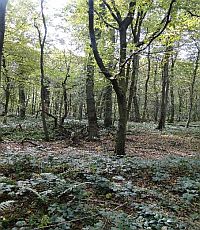
Participants visited an area of the protected Kottenforst. Considering that around 80% of this forest is planted, many strategies are being developed in order to recover species and conserve them. During the excursion the following conservation measures applied in this forest were explained: to have old wood (old trees), to leave dead wood of fallen trees i.e. to be habitat to some animals and to use old drainage areas to keep the water from the rain.
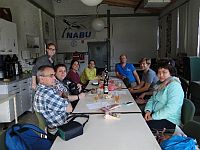
After both excursions participants from Bolivia and Germany and members of NABU discussed about both projects and stated valuable conclusions.
